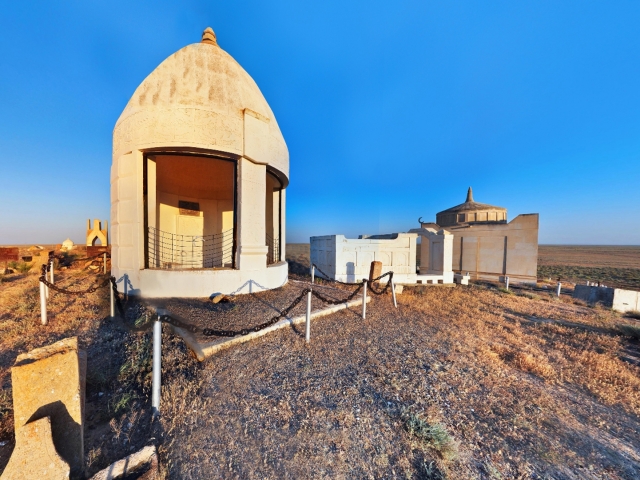Places
List of objects included in the map
Dossan Tazhiuly Mausoleum
Location: located in Mangistau district of Mangistau region, Karatobe Necropolis 5 km to the south-east from Shebir village.
Coordinates: N 44°45' 51.29" , E 52°16' 7.48"
Description of the Monument: The monument was first investigated in 1980 by expedition of the Ministry of Culture of the Kazakh SSR. Upon Resolution no. 38 by the Council of Ministers of the Kazakh SSR dated 20.01.1982 the necropolis was taken under state protection with republican value category. One of the most important events is the national liberation uprising of the Kazakhs in Mangistau against the imperial Russian colonists that took place in spring 1870 under the leadership of Dossan Tazhiuly and Issa Tilebaiuly. This is one of the most significant uprisings against the imperial colonists of the 19th century. Dossan Tazhiuly is a folk hero, organizer of the uprising against pressure of the Russian government and its leader.
Historical Data, Legends and Stories: Dossan Tazhiuly was born in 1829 in Zhideli, on the Buzachi Peninsula in Mangistau. His village was located between Khiva, Old Urgench, and Konyrat. In the area of Ushauyz Dossan's warriors defeated the punitive unit of Colonel Rukin who came to collect tribute from the Kazakh people. Moving from the Caucasus for the battle with a punitive unit he crossed Khiva. In 1874 a search unit of the Russian government headed by Anichkin seized Dossan's village in the Sam sands where he found the wounded warrior. He died two years later in prison of Fort-Shevchenko. The body of Dossan-batyr was taken to his native land Buzachi by a group of men under the leadership of Zhangabyl (father of the folk's akyn Sattigula Zhangabyluly). Poets Aktaban, Bala Oraz, Kalniyaz, Sattygul mentioned the heroic deed of Dossan-batyr in the poetry. People describe Dossan as fast, courageous and smart person. Names of Dossan and Issa who first rose against the colonialists for independence in Mangistau are certainly worth being considered one of the most sacred and valuable names in Mangistau in the modern era.
Source: 'Reference of Arabic Graph Texts on the Historical and Cultural Sites in Aral-Caspian Interfluve', volume 1, N.A. Kulbayev, Almaty-2015
Views: 3564
Video
3D Модель
Маршрут
Hazret Yerzhan Burial
Shopan Ata Necropolis and Underground Mosque
Shakpak Ata Necropolis and Underground Mosque (14th–19th centuries)
Khatam-Ishan Mausoleum
The earliest structures here date back to the second half of the 17th c. The necropolis was developed in time and space in a circle, i.e. the most ancient constructions remained in the center. Out of the two extant domed mausoleums, the structure in the southern part of the necropolis is of particular interest. ...











